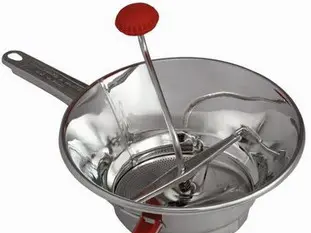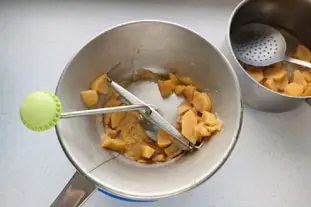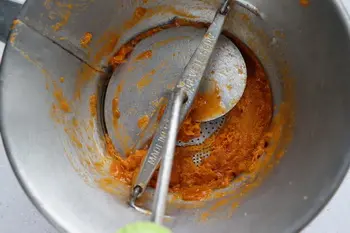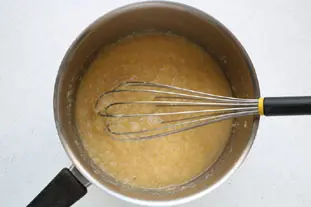This site uses only a few technical cookies necessary for its operation. By continuing to browse, you accept their use.
To find out more...
To find out more...
In Praise of the Vegetable Mill

When a recipe or preparation calls for something solid to be pureed, as in a soup for example, the natural reflex is to take out the blender and plunge it into the saucepan.
This works very well in most cases, but there are times when you'd like to puree something and at the same time remove the hard parts or skins from the preparation.
Another reflex in this case is to pass the whole preparation through a sieve or a very fine strainer, which also works well, but can be a bit tedious.
But there's a very old utensil, still in use today, which allows you to do both operations at once: it purées and retains the hard parts.
This works very well in most cases, but there are times when you'd like to puree something and at the same time remove the hard parts or skins from the preparation.
Another reflex in this case is to pass the whole preparation through a sieve or a very fine strainer, which also works well, but can be a bit tedious.
But there's a very old utensil, still in use today, which allows you to do both operations at once: it purées and retains the hard parts.
11 K 5/5 (4 reviews)
Keywords for this post:MillVegetablesUtensilUseClassicMaterialPuréeCoulisLast modified on: July 12th 2023
In Praise of the Vegetable Mill
The food mill is an entirely manual utensil that is simple, highly efficient and inexpensive.
It's a flared metal or plastic container, with a grid of more or less fine holes lining the bottom.
A plate, which turns with a simple crank, forces the poured preparation through the grid.
Place the mill on a container (saucepan, salad bowl, etc.) - it has 3 feet for this purpose - pour the preparation into it and turn the crank, "grinding" until all the preparation has passed through the grid, turning the crank in the other direction from time to time to clear the grid.
It's called a vegetable mill, because that's its original use, but it can be used with any fairly tender, often cooked, preparation that needs to be turned into a kind of purée (some even call it a "potato masher") or coulis, vegetables and soups of course, but also fruit, fruit purée or any other food tender enough for that.
It's ideal for this job, because it works without forcing or pulverizing like a blender would. As a result, mashed potatoes made in a blender quickly become sticky, which is never the case with a food mill.
And above all, of course, it separates.
Making fruit jelly, blackcurrant jelly for example, becomes much easier if you put the fruit through the food mill before cooking it.
My grandmother and mother had one, as did I, and I've converted my sons to them.
Over time, though, the principle hasn't changed one iota, the material is a little different: tin-plated iron in the olden days, stainless steel or plastic nowadays, but there's still no need to connect it to a power source, apart from elbow grease of course.
To sum up: the food mill is the essential manual tool for pureeing and separating the hard parts of cooked or fairly soft foods.
How does it work?

It's a flared metal or plastic container, with a grid of more or less fine holes lining the bottom.
A plate, which turns with a simple crank, forces the poured preparation through the grid.
Place the mill on a container (saucepan, salad bowl, etc.) - it has 3 feet for this purpose - pour the preparation into it and turn the crank, "grinding" until all the preparation has passed through the grid, turning the crank in the other direction from time to time to clear the grid.

At the end, all that's left to do is to discard (in the composter if possible) the hard parts remaining on the grid, and start again.
It's super-simple and highly effective.

Vegetables only?
It's called a vegetable mill, because that's its original use, but it can be used with any fairly tender, often cooked, preparation that needs to be turned into a kind of purée (some even call it a "potato masher") or coulis, vegetables and soups of course, but also fruit, fruit purée or any other food tender enough for that.
It's ideal for this job, because it works without forcing or pulverizing like a blender would. As a result, mashed potatoes made in a blender quickly become sticky, which is never the case with a food mill.
And above all, of course, it separates.
Making fruit jelly, blackcurrant jelly for example, becomes much easier if you put the fruit through the food mill before cooking it.
An old-fashioned utensil
My grandmother and mother had one, as did I, and I've converted my sons to them.
Over time, though, the principle hasn't changed one iota, the material is a little different: tin-plated iron in the olden days, stainless steel or plastic nowadays, but there's still no need to connect it to a power source, apart from elbow grease of course.
To sum up: the food mill is the essential manual tool for pureeing and separating the hard parts of cooked or fairly soft foods.
Lasts posts
Oven height
When we put a dish or cake in the oven, we naturally tend to put it on the middle shelf, and that's what we usually do. But in some cases, this position and height can be a little tricky, so let's find out why.October 8th 20251,8905
The importance of sieving
In recipes that use a fine powder (flour, powdered sugar, etc.), you'll often see the advice to sift before using it. To sift is to pass the powder in question through a sieve (a very fine strainer) before incorporating it into your recipe. It's often advice, but is it really useful?September 3rd 20257,0743
The grease spray
As soon as you have something in a recipe that sticks to the mold, the question always arises as to how difficult it is to remove from the mold. There's nothing more frustrating than breaking your cake when unmolding it, because part of it has stuck in the mold. The classic way to avoid this is...August 26th 20256,5585
Cake moulds
When we make a cake, or a cake of the same rectangular shape, we usually take out our usual mould and tell ourselves that the recipe is anyway "for a cake", but is it really that simple?August 25th 20256,6305
Thinning out herbs
If you need to add a long-stemmed herb (tarragon, mint, verbena, thyme, etc.) to a recipe, you'll probably only need the leaves and not the stem, so you'll need to remove the leaves. Leaf removal means keeping only the beautiful leaves, and eliminating the ugly stems and leaves, but how do you do...August 8th 20254,7465
Other pages you may also like
Steam for baking bread
What does steam have to do with bread-making? This is not only a bakers' secret, it is something you might not think of at all: if you make bread and bake it like a cake, you will end up with bread, but pale and with a thick, hard crust – a long way from the golden-brown crusty loaf you had in...June 16th 2021146 K4.5
Baking cakes
Where we see that to put a cake in the oven, once the dough is finished and in its mould, there is no hurry and that the cold is your friend.June 28th 201945 K4.1
Sausage broth
I've already talked to you about vegetable cooking water, which becomes a precious broth after cooking that would be a shame to throw away. Now let's look at the special case of meat cooking broth, and in particular sausages, which are often poached.June 28th 202312 K5
Fruits which can ruin your jelly
There are many ways of making a fruit mousse, but one of the simplest is to prepare a fruit jelly (basically a fresh fruit coulis with gelatine) and then mix this jelly before it sets completely with whipped cream. The result is perfect for filling a charlotte, for example. But do beware;...March 6th 201378 K4.0
Perpetual stock
It's something you have probably have done yourself: cooked or pre-cooked vegetables before adding them to a recipe. This is almost always done the same way: peel the chosen vegetables (carrots, for example), cut them up, boil them in salted water (using a tablespoon or so of coarse salt per litre),...November 22th 201630 K5
Post a comment or question
Follow this page
If you are interested in this page, you can "follow" it, by entering your email address here. You will then receive a notification immediately each time the page is modified or a new comment is added. Please note that you will need to confirm this following.
Note: We'll never share your e-mail address with anyone else.
Alternatively: you can subscribe to the mailing list of cooling-ez.com , you will receive a e-mail for each new recipe published on the site.









